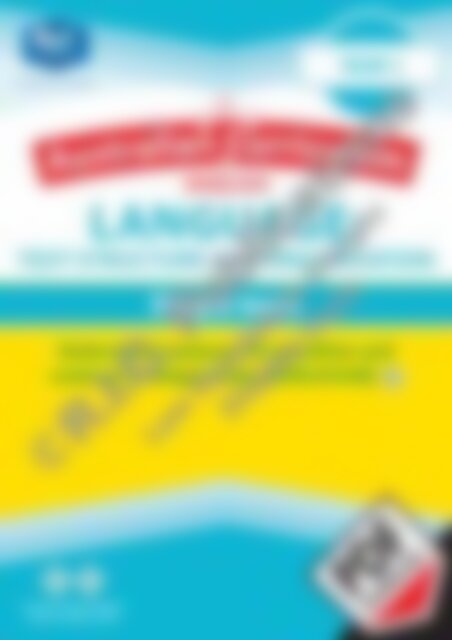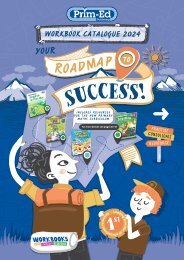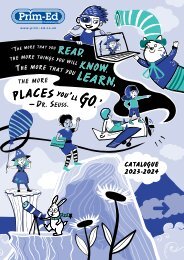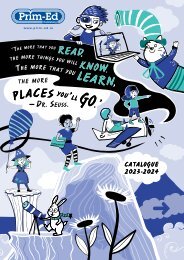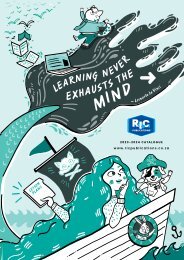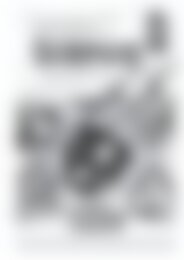20876 ACE Language (Yr 1) Simple Texts
You also want an ePaper? Increase the reach of your titles
YUMPU automatically turns print PDFs into web optimized ePapers that Google loves.
Your partner in education<br />
YEAR 1<br />
ENGLISH<br />
LANGUAGE:<br />
TEXT STRUCTURE AND ORGANISATION<br />
<strong>Simple</strong> texts<br />
Understand patterns of repetition and<br />
contrast in simple texts (<strong>ACE</strong>LA1448)<br />
Australian Primary Publisher<br />
of the Year 2015 and 2016
Australian Curriculum English – <strong>Language</strong>: Text structure and organisation (Year 1)<br />
Foreword<br />
Australian Curriculum English – <strong>Language</strong>: Text structure and organisation (Year 1) is one in a series of seven teacher<br />
resource books that support teaching and learning activities in Australian Curriculum English. The books focus on<br />
the sub-strand of Text structure and organisation within the <strong>Language</strong> strand of the national English curriculum.<br />
The resource books include theoretical background information, activities to develop the content descriptions, blackline<br />
masters, resource sheets and assessment checklists, along with interrelated links to other English strands and sub-strands.<br />
Titles in this series are:<br />
• Australian Curriculum English – <strong>Language</strong>: Text structure and organisation (Foundation)<br />
• Australian Curriculum English – <strong>Language</strong>: Text structure and organisation (Year 1)<br />
• Australian Curriculum English – <strong>Language</strong>: Text structure and organisation (Year 2)<br />
• Australian Curriculum English – <strong>Language</strong>: Text structure and organisation (Year 3)<br />
• Australian Curriculum English – <strong>Language</strong>: Text structure and organisation (Year 4)<br />
• Australian Curriculum English – <strong>Language</strong>: Text structure and organisation (Year 5)<br />
• Australian Curriculum English – <strong>Language</strong>: Text structure and organisation (Year 6)<br />
Contents<br />
Format of this book .................................. iv – v<br />
<strong>Language</strong>: Text structure and<br />
organisation .............................................. 2–85<br />
Understand that the purposes texts serve shape their<br />
structure in predictable ways (<strong>ACE</strong>LA1477)<br />
© Australian Curriculum: Assessment and Reporting Authority 2012<br />
–Teacher information ................................................. 2<br />
–Activities to develop the content description ...... 3–10<br />
–Blackline masters ............................................. 11–25<br />
–Assessment checklist ............................................. 26<br />
–Interrelated English links ........................................ 27<br />
– Modes, capabilities and priorities covered by the<br />
activities in this content description ....................... 27<br />
Understand patterns of repetition and contrast in<br />
simple texts (<strong>ACE</strong>LA1448)<br />
© Australian Curriculum: Assessment and Reporting Authority 2012<br />
–Teacher information ............................................... 28<br />
–Activities to develop the content description .......... 29<br />
–Blackline masters and resource sheets .............. 30–51<br />
–Assessment checklist ............................................. 52<br />
–Interrelated English links ........................................ 53<br />
– Modes, capabilities and priorities covered by the<br />
activities in this content description ....................... 53<br />
Recognise that different types of punctuation, including full<br />
stops, question marks and exclamation marks, signal<br />
sentences that make statements, ask questions, express<br />
emotion or give commands (<strong>ACE</strong>LA1449)<br />
© Australian Curriculum: Assessment and Reporting Authority 2012<br />
–Teacher information ............................................... 54<br />
–Activities to develop the content description ......... 55<br />
–Blackline masters and resource sheets ............. 56–69<br />
–Assessment checklist ............................................. 70<br />
–Interrelated English links ........................................ 71<br />
– Modes, capabilities and priorities covered by the<br />
activities in this content description ....................... 71<br />
Understand concepts about print and screen, including how<br />
different types of texts are organised using page<br />
numbering, tables of content, headings and titles,<br />
navigation buttons, bars and links (<strong>ACE</strong>LA1450)<br />
© Australian Curriculum: Assessment and Reporting Authority 2012<br />
–Teacher information ............................................... 72<br />
–Activities to develop the content description .......... 73<br />
–Blackline masters and resource sheets ............. 74–83<br />
–Assessment checklist ............................................. 84<br />
–Interrelated English links ........................................ 85<br />
– Modes, capabilities and priorities covered by the<br />
activities in this content description ....................... 85<br />
Answers ................................................... 86–90<br />
R.I.C. Publications ® www.ricpublications.com.au Australian Curriculum English – <strong>Language</strong>: Text structure and organisation (Year 1)<br />
iii
Format of the book<br />
This teacher resource book includes supporting materials for teaching and learning in the sub-strand of Text structure and<br />
organisation within the strand of <strong>Language</strong> in Australian Curriculum English. All content descriptions in the sub-strand<br />
have been included, as well as teaching points based on the Curriculum’s elaborations.<br />
While the book focuses on the sub-strand of Text structure and organisation, activities and interrelated links to other<br />
strands and sub-strands have been incorporated.<br />
Each section supports a specific content description and follows a consistent format, containing the following information<br />
over several pages:<br />
• activities to develop the content descriptions • student blackline masters • resource sheets<br />
• interrelated English links<br />
• assessment checklist<br />
Answers relating to student blackline masters have been included at the back of the book.<br />
The length of each content description section varies.<br />
Teacher information includes background information relating to the content description, as well as<br />
related terms and desirable student vocabulary and other useful details which may assist the teacher.<br />
Related terms includes vocabulary<br />
associated with the content description.<br />
Many of these relate to the glossary<br />
in the back of the official Australian<br />
Curriculum English document;<br />
additional related terms may also have<br />
been added.<br />
Student vocabulary includes words<br />
which the teacher would use—<br />
and expect the students to learn,<br />
understand and use—during English<br />
lessons.<br />
Further resources by R.I.C.<br />
Publications or other publishers<br />
or authors are included where<br />
appropriate.<br />
?<br />
T<br />
E<br />
What this means<br />
provides a general<br />
explanation of the<br />
content description.<br />
Teaching points<br />
provides a list of<br />
the main teaching<br />
points relating to the<br />
content description.<br />
Elaborations are a<br />
list of elaborations<br />
based on those in the<br />
content description.<br />
Activities to develop the content<br />
description includes descriptions or<br />
instructions for activities or games<br />
relating to the content descriptions<br />
or elaborations. Some activities are<br />
supported by blackline masters or<br />
resource sheets. Where applicable,<br />
these will be stated for easy reference.<br />
Australian Curriculum English – <strong>Language</strong>: Text structure and organisation (Year 1) www.ricpublications.com.au R.I.C. Publications ®<br />
iv
Format of the book<br />
Blackline masters and resource<br />
sheets are provided to support<br />
teaching and learning activities<br />
for each content description.<br />
These include worksheets for<br />
class use, games, charts or other<br />
materials which the teacher might<br />
find useful to use or display in<br />
the classroom. For each blackline<br />
master or resource sheet, the<br />
content description to which it<br />
relates is given.<br />
Each section has a checklist<br />
which teachers may find useful as<br />
a place to keep a record of their<br />
observations of the activities to<br />
develop the content descriptions.<br />
Interrelated English links<br />
lists other links covered within<br />
the <strong>Language</strong> strand, Literature<br />
strand and Literacy strand of<br />
English that are incorporated in<br />
the activities provided with the<br />
content description. While the<br />
book’s approach focuses on the<br />
Text structure and organisation<br />
sub-strand, the links show the<br />
integration across the three<br />
strands.<br />
A table showing the <strong>Language</strong><br />
modes, General capabilities<br />
and Cross-curriculum priorities<br />
covered by the activities in each<br />
content description is provided.<br />
Answers for student worksheets<br />
are provided at the back of the<br />
book.<br />
R.I.C. Publications ® www.ricpublications.com.au Australian Curriculum English – <strong>Language</strong>: Text structure and organisation (Year 1)<br />
v
Text structure<br />
and organisation<br />
Understand patterns of repetition and contrast in simple texts (<strong>ACE</strong>LA1448)<br />
© Australian Curriculum: Assessment and Reporting Authority 2012<br />
Related terms<br />
Repetition<br />
The act of repeating; repeated action; repeated<br />
utterance; reiteration<br />
Class/Subclass<br />
Classifi cations of words into larger (class) and<br />
smaller (subclass) groups. For example, class–<br />
animals, subclasses–farm animals and domestic<br />
animals.<br />
Part/whole<br />
Words or vocabulary to describe parts of a<br />
whole topic. Parts may be, for example, single<br />
words such as nose, eyes, ears, paws, tail to<br />
describe parts of a whole topic, in this case a<br />
dog.<br />
Compare/contrast<br />
Similarities and differences in texts<br />
Cause/effect<br />
A link in a text which shows an action (cause)<br />
and the effect it creates. Often associated with<br />
the conjunctions ‘as’, ‘because’ and ‘since’.<br />
Word association<br />
Words linked in some way<br />
Word collocation<br />
A group of related words, or words that<br />
typically occur together. For example, Once<br />
upon a time ..., ... lived happily ever after;<br />
collar, bone, bowl, walk, dog tag, basket.<br />
rhyme<br />
same<br />
Student vocabulary<br />
word/words<br />
different<br />
group<br />
repeat<br />
repetition<br />
pattern<br />
text<br />
?<br />
T<br />
E<br />
What this means<br />
Teacher information<br />
• When reading texts, students will begin to recognise patterns in vocabulary use<br />
which will help them decipher current and future texts.<br />
• Vocabulary patterns may include repetition of words and phrases, links between<br />
groups of words, using words to compare and contrast topics, using words<br />
associated with a (whole) topic to describe different parts, and using words which<br />
indicate cause and effect.<br />
• There are different types of texts including recounts and procedures and these have<br />
language features which distinguish them from other text types.<br />
• Stories and poetry have specifi c features of language including repetition.<br />
• Patterns give cohesiveness to texts which help students link ideas.<br />
• Discussion about texts develops understanding of literary concepts, communication<br />
and cooperative skills.<br />
Teaching points<br />
• Students should be made aware of repeated patterns of words and phases in texts<br />
including stories and poetry.<br />
• Students develop a wider vocabulary base as they read new texts.<br />
• Students can see connections between words in a current or previously-read text.<br />
• Students can see differences and similarities between texts and words in texts.<br />
• Students will discuss the language features of texts including patterns and<br />
repetition.<br />
Elaborations<br />
E1. Identifying patterns of words including smaller groups relating to larger groups,<br />
words which relate to topics as a whole, words which compare or contrast topics in<br />
a text, words which show cause and effect, words or phrases which are connected<br />
by repetition throughout a text, or words which usually occur together.<br />
E2. Discussing different text types including stories and poetry and identifying their<br />
features including language patterns and repetition.<br />
Further resources<br />
• Primary comprehension Book A published by R.I.C. Publications<br />
• Teaching comprehension strategies Book A published by R.I.C. Publications<br />
• Early literacy games published by R.I.C. Publications<br />
• ELF emergent reading program published by R.I.C. Publications<br />
• Early years themes—Fairytales published by R.I.C. Publications<br />
Australian Curriculum English – <strong>Language</strong>: Text structure and organisation (Year 1) www.ricpublications.com.au R.I.C. Publications ®<br />
28
Text structure<br />
and organisation<br />
Understand patterns of repetition and contrast in simple texts<br />
(<strong>ACE</strong>LA1448)<br />
© Australian Curriculum: Assessment and Reporting Authority 2012<br />
Activities to<br />
develop the<br />
content description<br />
E1. Identifying patterns of words including smaller groups relating to larger groups, words which<br />
relate to topics as a whole, words which compare or contrast topics in a text, words which show<br />
cause and effect, words or phrases which are connected by repetition throughout a text, or words<br />
which usually occur together.<br />
• Repetition in texts (pages 30 to 36)<br />
During shared, home or free reading, expose the students to a variety of texts which include repetition used in various ways. These could include<br />
repeated use of the name of a character in a story (Harris the helicopter—page 30), repeated sentence structure (Eating, working, playing and<br />
sleeping—page 31), repeated use of sounds as alliteration (Ten tiny tigers—page 32), repeated rhymes in a poem (The four dragons—page<br />
33), repeated use of verbs to begin steps in a procedure (Magic trick—page 34), repeated chorus after a verse in a song (I’m a nut—page 35), or<br />
repeated call and response (The littlest worm—page 36). Repetition helps students link ideas in a text.<br />
• Contrast in texts (pages 37 to 45)<br />
– Why the whale spouts and the starfish looks ragged (page 37)<br />
Read texts such as the one provided with the students and ask them (in simple terms) to<br />
identify words which connect ideas in a text which show cause and effect. Examples<br />
include words such as ‘because’,’so’, ‘since’, ‘consequently’, ‘due to’, ‘owing to’, ‘because<br />
of this’ etc. These ‘text connective’ words give cohesion to stories and poems and may<br />
include grammar such as conjunctions.<br />
– At the pet shop/On the farm (page 38)<br />
Ask the students to identify, by circling or underlining words in a simple<br />
text relating to a topic, to show connections between words. Use<br />
separately or together.<br />
– Word card sorts (pages 39 and 40)<br />
Play games which ask the students to sort word cards into smaller<br />
groups relating to a topic or theme. Page 39 includes land, sea and<br />
air transport; page 40 includes names of sports/games, equipment<br />
and people involved in sports.<br />
– Whose home am I? (page 41)<br />
Read and ask the students to identify words which are parts of a<br />
topic. Later, as students write longer texts, these words may form<br />
the basis for information in a paragraph. In the text provided on<br />
page 41, the students will identify words relating to homes—walls,<br />
fl oor, roof, door, window, garden, neighbourhood etc.<br />
– Animals move/The opposites story (pages 42 and 43)<br />
Expose students to the use of literary devices such as synonyms (similar meaning words) and antonyms (opposites) and discuss how they relate to<br />
other words in the text.<br />
– Hey little fly!/How the first butterflies were born (pages 44 and 45)<br />
Read texts which show connections between opposing viewpoints (page 44) such as in persuasive texts, or different imagery in poetry (page 45). The<br />
poem on page 44 is loosely based on the story Hey, little ant by Phillip Hoose.<br />
Interrelated English links: See page 53<br />
E2. Discussing different text types including stories and poetry and identifying their features including<br />
language patterns and repetition.<br />
• Loawnu the wise woman/A monster of a machine/Make a healthy snack (pages 46 to 51)<br />
Encourage students to look closely at texts for particular language features to help them better understand concepts about texts. Constant exposure also<br />
provides devices which students could employ in their own writing. <strong>Simple</strong> text examples have been provided including a narrative (Loawnu the wise<br />
woman), poem (A monster of a machine) and a procedure (Make a healthy snack) with corresponding language features checklists. <strong>Language</strong><br />
features can include sentence structure, vocabulary, punctuation and fi gurative language as well as illustrations, diagrams and graphics. (ACARA glossary<br />
page 75) NOTE: This section does not include text structure which is covered in <strong>ACE</strong>LA1447.<br />
Interrelated English links: See page 53<br />
R.I.C. Publications ® www.ricpublications.com.au Australian Curriculum English – <strong>Language</strong>: Text structure and organisation (Year 1)<br />
29
Harris the helicopter<br />
(repeated character in a text)<br />
Resource sheet<br />
Harris the helicopter smiled.<br />
Harris started his engine.<br />
Br-r-r-r!<br />
Harris spun his blades.<br />
Whir-r-r-r!<br />
Harris lifted into the air.<br />
The wind brushed his body and pushed against his blades.<br />
Harris glided over the city and towards the hills.<br />
Harris swooped down towards the lake.<br />
He scooped up his load of water.<br />
Harris lifted his load into the air.<br />
He carried it over the burning bush.<br />
Harris dropped his load of water onto the fire.<br />
Load after load, Harris drowned the fire.<br />
It smoked and died.<br />
Tiny people waved at Harris from the ground.<br />
Harris dipped his blades and headed for his hangar.<br />
With a smile, Harris closed his eyes.<br />
Another job well done!<br />
Understand patterns of repetition and contrast in simple texts (<strong>ACE</strong>LA1448)<br />
© Australian Curriculum: Assessment and Reporting Authority 2012<br />
Australian Curriculum English – <strong>Language</strong>: Text structure and organisation (Year 1) www.ricpublications.com.au R.I.C. Publications ®<br />
30
Eating, working, playing and<br />
sleeping (repeated sentence structure)<br />
Resource sheet<br />
I had toast for breakfast.<br />
Dad had eggs.<br />
My big brother had a banana and a glass of milk.<br />
Mum had cereal.<br />
But my goldfish have fish flakes for breakfast.<br />
I worked at school today.<br />
Dad worked at the office.<br />
My big brother worked at high school.<br />
Mum worked at the hospital.<br />
But my goldfish didn’t work at all.<br />
I play with my computer.<br />
Understand patterns of repetition and contrast in simple texts (<strong>ACE</strong>LA1448)<br />
© Australian Curriculum: Assessment and Reporting Authority 2012<br />
Dad plays with his laptop.<br />
My big brother plays with his iPad .<br />
Mum plays with her iPhone .<br />
But my goldfish play with each other.<br />
I go to bed at 8 o’clock.<br />
Dad goes to bed at 11 o’clock.<br />
My big brother goes to bed at half past nine.<br />
Mum goes to bed at 10 o’clock.<br />
But I don’t think my goldfish go to sleep at all!<br />
R.I.C. Publications ® www.ricpublications.com.au Australian Curriculum English – <strong>Language</strong>: Text structure and organisation (Year 1)<br />
31
Ten tiny tigers (repeated sounds at the<br />
beginning of words in a sentence)<br />
Resource sheet<br />
Ten tiny tigers lurking in a line.<br />
One wandered away and then there were nine.<br />
Nine tiny tigers going through the gate.<br />
One bumped into it and then there were eight.<br />
Eight tiny tigers trying hard to listen.<br />
One heard a scary sound and then there were seven.<br />
Seven tiny tigers scratching at some sticks.<br />
One found a new game and then there were six.<br />
Six tiny tigers found a buzzing beehive.<br />
One swatted it with his paw and then there were five.<br />
Five tiny tigers heard the seashore.<br />
One spied a seashell and then there were four.<br />
Four tiny tigers tired as tired can be.<br />
One fell fast asleep and then there were three.<br />
Three tiny tigers in a cage in the zoo.<br />
One stopped to watch the people and then there were two.<br />
Two tiny tigers searching for their mum.<br />
One meowed sadly and then there was one.<br />
One big tigress looking for tiny tiger cubs.<br />
One loud growl and ... here they come!<br />
Understand patterns of repetition and contrast in simple texts (<strong>ACE</strong>LA1448)<br />
© Australian Curriculum: Assessment and Reporting Authority 2012<br />
Australian Curriculum English – <strong>Language</strong>: Text structure and organisation (Year 1) www.ricpublications.com.au R.I.C. Publications ®<br />
32
The four dragons (repeated sounds in rhyming<br />
words in a poem based on an Asian folktale)<br />
Resource sheet<br />
Once upon a time in an Asian sea<br />
Lived four large dragons who were wild and free.<br />
The Long Dragon, Yellow Dragon, Black Dragon and Pearl<br />
Played among the clouds with a swoop and a whirl.<br />
One day they heard crying from below.<br />
People were praying for rain to make crops grow.<br />
The dragons begged the Jade Emperor to help<br />
But he could not be bothered—he only cared about himself.<br />
Understand patterns of repetition and contrast in simple texts (<strong>ACE</strong>LA1448)<br />
© Australian Curriculum: Assessment and Reporting Authority 2012<br />
So the dragons thought of a clever plan<br />
To help the people and save the land.<br />
They flew to the sea scooping water in their mouths<br />
Drenching the earth and breaking the drought.<br />
When the Emperor found out what the dragons had done<br />
He buried each beneath a mountain and thought he had won.<br />
But the dragons changed to rivers flowing from the mountains to<br />
the sea<br />
Watering the land and making the people as happy as could be.<br />
R.I.C. Publications ® www.ricpublications.com.au Australian Curriculum English – <strong>Language</strong>: Text structure and organisation (Year 1)<br />
33
Magic trick—floating paperclip<br />
(repeated use of verbs to begin steps in a procedure)<br />
Resource sheet<br />
Make a paperclip float.<br />
1.<br />
2.<br />
3.<br />
You will need<br />
• two metal paperclips • bowl • water<br />
1.<br />
2.<br />
3.<br />
Steps<br />
1. Fill the bowl about halfway<br />
with water.<br />
2. Open out one paperclip to<br />
make an ‘L’ shape.<br />
3. Hold the opened-out<br />
paperclip by the top.<br />
4. Place the other paperclip<br />
carefully onto the first one.<br />
5. Lower them slowly onto the<br />
surface of the water.<br />
1.<br />
2.<br />
3.<br />
6. Lower the opened out<br />
paperclip into the water.<br />
7. Move it carefully away from<br />
the other paperclip.<br />
8. Watch the other paperclip<br />
float on the water surface.<br />
Test<br />
Is your paperclip floating on top of the water?<br />
Understand patterns of repetition and contrast in simple texts (<strong>ACE</strong>LA1448)<br />
© Australian Curriculum: Assessment and Reporting Authority 2012<br />
Australian Curriculum English – <strong>Language</strong>: Text structure and organisation (Year 1) www.ricpublications.com.au R.I.C. Publications ®<br />
34
I’m a nut (traditional)<br />
(repeated chorus after a verse in a song)<br />
Resource sheet<br />
I’m an acorn, small and round<br />
Lying on the cold, cold ground.<br />
Everyone walks over me.<br />
That is why I’m cracked you see.<br />
I’m a nut!<br />
I’m a nut!<br />
I’m a nut!<br />
(Two tongue clicks or finger snaps)<br />
(Two tongue clicks or finger snaps)<br />
(Two tongue clicks or finger snaps)<br />
Called myself on the telephone<br />
Just to hear my golden tone.<br />
Asked me out for a little date.<br />
Picked me up about half past eight.<br />
I’m a nut!<br />
(Two tongue clicks or finger snaps)<br />
Understand patterns of repetition and contrast in simple texts (<strong>ACE</strong>LA1448)<br />
© Australian Curriculum: Assessment and Reporting Authority 2012<br />
I’m a nut! (Two tongue clicks or finger snaps)<br />
I’m a nut! (Two tongue clicks or finger snaps)<br />
Took myself to the movie show.<br />
Stayed too late and said, ‘Let’s go!’<br />
Took my hand and led me out.<br />
Drove me home and gave a shout!<br />
I’m a nut! (Two tongue clicks or finger snaps)<br />
I’m a nut! (Two tongue clicks or finger snaps)<br />
I’m a nut! (Two tongue clicks or finger snaps)<br />
R.I.C. Publications ® www.ricpublications.com.au Australian Curriculum English – <strong>Language</strong>: Text structure and organisation (Year 1)<br />
35
The littlest worm (traditional)<br />
(repeated call and response in a song)<br />
Resource sheet<br />
The littlest worm (repeat as an echo)<br />
I ever saw (repeat as an echo)<br />
Was stuck inside my drinking straw. (repeat as an echo)<br />
The littlest worm I ever saw was stuck<br />
inside my drinking straw. (all together)<br />
I took a sip (repeat as an echo)<br />
And he went down (repeat as an echo)<br />
Right through my pipes. (repeat as an echo)<br />
He’ll surely drown. (repeat as an echo)<br />
I took a sip and he went down, right through<br />
my pipes. He’ll surely drown. (all together)<br />
I burped him up (repeat as an echo)<br />
And he was dead. (repeat as an echo)<br />
I buried him (repeat as an echo)<br />
In a flowerbed. (repeat as an echo)<br />
I burped him up and he was dead. I buried<br />
him in a flowerbed. (all together)<br />
He was my pal. (repeat as an echo)<br />
He was my friend (repeat as an echo)<br />
And now he’s gone (repeat as an echo)<br />
And now he’s dead. (repeat as an echo)<br />
He was my pal. He was my friend and now<br />
he’s gone and now he’s dead. (all together)<br />
Understand patterns of repetition and contrast in simple texts (<strong>ACE</strong>LA1448)<br />
© Australian Curriculum: Assessment and Reporting Authority 2012<br />
Australian Curriculum English – <strong>Language</strong>: Text structure and organisation (Year 1) www.ricpublications.com.au R.I.C. Publications ®<br />
36
Why the whale spouts and the<br />
starfish looks ragged<br />
(cause and effect with words like ‘because’, ‘since’, ‘so’)<br />
Resource sheet<br />
Once, long ago, when the world was new, all the Australian animals<br />
were men.<br />
The men lived in a land a long way from Australia. They decided to<br />
travel there because the hunting was good and the weather was<br />
sunny. It would be a hard journey so they needed a good canoe.<br />
Whale, the biggest man, had a big, strong canoe. The other men<br />
planned to steal the canoe because Whale would not share.<br />
Starfish crept close to Whale and said,<br />
‘You have lots of insects in your hair.<br />
Let me get them out for you’.<br />
Whale was very pleased, so he moored<br />
his canoe in deep water and sat on a<br />
rock. Starfish told funny stories and<br />
scratched hard on Whale’s head so<br />
he could not hear the others as they<br />
stole the canoe and rowed away. Soon<br />
Whale had a large wound on his head.<br />
Understand patterns of repetition and contrast in simple texts (<strong>ACE</strong>LA1448)<br />
© Australian Curriculum: Assessment and Reporting Authority 2012<br />
Whale grew bored with stories and looked for his canoe. When<br />
he saw it far away, he knew Starfish had tricked him. He was very<br />
angry, so he threw Starfish against the rocks until he was covered<br />
with jagged cuts. Starfish rolled away and hid in the sand.<br />
Whale chased his canoe. As he swam through the water, large<br />
waves crashed over him and squirted from the wound on his head.<br />
The men reached Australia with Whale not far behind. Whale was<br />
very angry because his canoe was wrecked on the shore. He spouted<br />
water high into the air through the hole in his head.<br />
To this day, all starfish look like they have ragged cuts on their<br />
bodies and whales spout water through their heads.<br />
R.I.C. Publications ® www.ricpublications.com.au Australian Curriculum English – <strong>Language</strong>: Text structure and organisation (Year 1)<br />
37
At the pet shop/On the farm<br />
At the pet shop<br />
Draw a line under all the pet animal words in the text.<br />
Today, Mum took me to the pet shop. I wanted a pet.<br />
The rabbits were cute and soft.<br />
The white mice were cute and soft.<br />
The kittens were cute and soft.<br />
The puppies were cute and soft.<br />
The guinea pigs were cute and soft.<br />
The hermit crabs were different.<br />
We bought a crab and took it home.<br />
On the farm<br />
Circle all the farm animal words in the text.<br />
The rooster crowed at the hen. The hen cackled at the chickens.<br />
The bull bellowed at the cow. The cow mooed at the calves.<br />
The stallion neighed at the mare. The mare whinnied at the foal.<br />
The boar grunted at the sow. The sow squealed at the piglets.<br />
The ram bleated at the ewe. The ewe bleated at the lambs.<br />
Farmer Smith yelled at them all to be quiet!<br />
Understand patterns of repetition and contrast in simple texts (<strong>ACE</strong>LA1448)<br />
© Australian Curriculum: Assessment and Reporting Authority 2012<br />
Australian Curriculum English – <strong>Language</strong>: Text structure and organisation (Year 1) www.ricpublications.com.au R.I.C. Publications ®<br />
38
Word card sort – 1<br />
Resource sheet<br />
car yacht speedboat<br />
helicopter motorcycle aeroplane<br />
jetski hot air balloon truck<br />
Understand patterns of repetition and contrast in simple texts (<strong>ACE</strong>LA1448)<br />
© Australian Curriculum: Assessment and Reporting Authority 2012<br />
submarine jet bicycle<br />
van canoe glider<br />
R.I.C. Publications ® www.ricpublications.com.au Australian Curriculum English – <strong>Language</strong>: Text structure and organisation (Year 1)<br />
39
Word card sort – 2<br />
Resource sheet<br />
soccer cap player<br />
shoes coach cricket<br />
glove basketball referee<br />
ball tennis batter<br />
bowler bat swimming<br />
Understand patterns of repetition and contrast in simple texts (<strong>ACE</strong>LA1448)<br />
© Australian Curriculum: Assessment and Reporting Authority 2012<br />
Australian Curriculum English – <strong>Language</strong>: Text structure and organisation (Year 1) www.ricpublications.com.au R.I.C. Publications ®<br />
40
Whose home am I?<br />
(words and phrases as parts of a whole topic of a text)<br />
Resource sheet<br />
My home is shaped like a sphere. The walls of my home are<br />
rounded. I made them myself.<br />
My home is up<br />
high. There are<br />
many homes<br />
like mine in the<br />
neighbourhood.<br />
The roof of my<br />
home is green and<br />
brown.<br />
There is no door<br />
on my home so I<br />
can come and go<br />
quickly during the<br />
night.<br />
Understand patterns of repetition and contrast in simple texts (<strong>ACE</strong>LA1448)<br />
© Australian Curriculum: Assessment and Reporting Authority 2012<br />
I have no windows<br />
but I can easily see<br />
everything around<br />
me.<br />
The floor of my<br />
home is covered<br />
with grass and<br />
shredded bark. It<br />
is very cosy.<br />
There is only one room in my home but it is big enough for two<br />
adults and many children.<br />
In my garden, there are many leaves, fruits and flowers which I love<br />
to eat. My favourite are fresh, new leaves.<br />
My home is called a drey. But who lives here?<br />
R.I.C. Publications ® www.ricpublications.com.au Australian Curriculum English – <strong>Language</strong>: Text structure and organisation (Year 1)<br />
41
Animals move<br />
(contrast in texts using synonyms)<br />
Cut out and glue the words in the correct sentences.<br />
1. Worms .<br />
2. Birds .<br />
3. Fish .<br />
4. Monkeys .<br />
5. Caterpillars .<br />
6. Snails .<br />
7. Frogs .<br />
8. Ducks .<br />
9. Jerboas .<br />
swim fly wriggle<br />
waddle crawl slide<br />
hop climb jump<br />
Understand patterns of repetition and contrast in simple texts (<strong>ACE</strong>LA1448)<br />
© Australian Curriculum: Assessment and Reporting Authority 2012<br />
Australian Curriculum English – <strong>Language</strong>: Text structure and organisation (Year 1) www.ricpublications.com.au R.I.C. Publications ®<br />
42
The opposites story<br />
(contrast in texts using antonyms)<br />
Resource sheet<br />
Mouse is little but elephant is big. Elephant is old but mouse is<br />
young. Mouse is light but elephant is heavy. Elephant loves the rain<br />
but mouse hates the rain.<br />
First, the rain is light, then it becomes heavy. Mouse is sad but<br />
elephant is happy. Mouse’s umbrella is over him but elephant is<br />
under his umbrella.<br />
Understand patterns of repetition and contrast in simple texts (<strong>ACE</strong>LA1448)<br />
© Australian Curriculum: Assessment and Reporting Authority 2012<br />
The rivers in the jungle are nearly empty but they are soon full of<br />
water. Mouse starts to run quickly but elephant can only run slowly.<br />
The hill seems very far away but it is soon close enough to climb.<br />
‘We’re safe!’ squeaks mouse.<br />
‘Yes’, trumpets elephant. ‘Time for a long, hot shower!’<br />
‘Or a short bath!’ replies mouse.<br />
And they both grin.<br />
R.I.C. Publications ® www.ricpublications.com.au Australian Curriculum English – <strong>Language</strong>: Text structure and organisation (Year 1)<br />
43
Hey little fly!<br />
(opposing viewpoints)<br />
Resource sheet<br />
(Spider) Hey little fly caught in my trap!<br />
You’re my dinner! What do you think of that!<br />
(Fly)<br />
Please, oh please! Do not eat me!<br />
I have many children and they all need me!<br />
(Spider) What a lie! Everyone knows that flies don’t care.<br />
They’re annoying pests that get in your hair.<br />
(Fly)<br />
Please, oh please! Do not eat me!<br />
I’m way too small to be tasty!<br />
(Spider) You may be small while I am bigger.<br />
(Fly)<br />
But flies are an important part of my dinner!<br />
I may be pesky but I have my uses.<br />
I clean up everyone’s garbage<br />
and messes.<br />
We’ll leave the story there<br />
before it ends.<br />
Should the spider eat the fly?<br />
Who will you defend?<br />
Understand patterns of repetition and contrast in simple texts (<strong>ACE</strong>LA1448)<br />
© Australian Curriculum: Assessment and Reporting Authority 2012<br />
Australian Curriculum English – <strong>Language</strong>: Text structure and organisation (Year 1) www.ricpublications.com.au R.I.C. Publications ®<br />
44
How the first butterflies were born<br />
(contrasting imagery in a poem)<br />
Resource sheet<br />
Long ago in the Dreamtime, no creature ever died<br />
Until one day a young cockatoo fell from a branch so high.<br />
His neck was broken. The animals cried<br />
But the spirits carried him up into the sky.<br />
Now this was new to the animals, so they<br />
really wanted to know<br />
How the spirits changed the animals who<br />
died on the earth below.<br />
They asked for volunteers but no-one<br />
came forward<br />
Except some caterpillars who chomped<br />
and wriggled.<br />
The caterpillars would camp in the sky<br />
for the winter,<br />
Find out and return when the weather was warmer.<br />
Understand patterns of repetition and contrast in simple texts (<strong>ACE</strong>LA1448)<br />
© Australian Curriculum: Assessment and Reporting Authority 2012<br />
During the dark winter, a cold blanket covered the land.<br />
The animals waited and waited for the wriggly band.<br />
The days grew brighter. Warm fingers stroked the world.<br />
At last they saw creatures descending with wings unfurled.<br />
The brightly coloured butterflies were the first ever known.<br />
The animals then realised the kindness the spirits had shown.<br />
And from that day, caterpillars sleep through the winter in their<br />
cosy cocoons<br />
And emerge—changed—when spring returns.<br />
R.I.C. Publications ® www.ricpublications.com.au Australian Curriculum English – <strong>Language</strong>: Text structure and organisation (Year 1)<br />
45
Loawnu the wise woman<br />
(An Asian folktale — narrative)<br />
Resource sheet<br />
One warm spring day in China,<br />
some children went out to the fields<br />
to play.<br />
They found some parts of the sky on<br />
the ground.<br />
They ran to Loawnu, the wise woman.<br />
‘The sky is falling!’ they said. ‘What will we do?’<br />
Loawnu smiled sweetly and said, ‘Go back<br />
to the field and collect all the pieces of the<br />
sky. I will sew them back together for you<br />
before the festival’.<br />
The spring festival was a very important<br />
celebration for the village. All the young men<br />
and women were to gather in the village to<br />
find husbands and wives. The village would<br />
be very embarrassed if people found out the sky had fallen.<br />
The children quickly picked up all the pieces of the sky and took<br />
them to Laownu.<br />
‘Some are missing!’ they told Loawnu sadly.<br />
‘Don’t worry,’ she said with a secret smile. But the children still<br />
worried.<br />
The next morning, when they woke up, the children looked up<br />
at the sky. It was just as clear and blue as before. They were very<br />
happy.<br />
But that night, they got a big surprise! Instead of dark night, bright<br />
twinkling light filled the spaces where the missing pieces of the sky<br />
should have been.<br />
Loawnu the wise woman had cleverly fixed the sky!<br />
Understand patterns of repetition and contrast in simple texts (<strong>ACE</strong>LA1448)<br />
© Australian Curriculum: Assessment and Reporting Authority 2012<br />
Australian Curriculum English – <strong>Language</strong>: Text structure and organisation (Year 1) www.ricpublications.com.au R.I.C. Publications ®<br />
46
Narrative language features checklist<br />
Tick and write:<br />
Nouns that<br />
name people,<br />
places or<br />
things<br />
Pronouns<br />
that stand<br />
in place of<br />
nouns<br />
Adjectives<br />
that describe<br />
nouns<br />
Write three.<br />
Write three.<br />
Write three.<br />
Verbs that<br />
show action<br />
Write three.<br />
Understand patterns of repetition and contrast in simple texts (<strong>ACE</strong>LA1448)<br />
© Australian Curriculum: Assessment and Reporting Authority 2012<br />
Adverbs that<br />
describe verbs<br />
Interesting<br />
words<br />
Write three.<br />
Write three.<br />
Punctuation Capital letters<br />
Full stops<br />
Question marks<br />
Exclamation marks<br />
R.I.C. Publications ® www.ricpublications.com.au Australian Curriculum English – <strong>Language</strong>: Text structure and organisation (Year 1)<br />
47<br />
Illustrations,<br />
diagrams or<br />
graphics
A monster of a machine<br />
(A poem)<br />
Resource<br />
RESOURCE<br />
sheet<br />
SHEET<br />
Our washing machine must have eaten Dad’s socks.<br />
There’s nothing really strange about that!<br />
He can only find one so it’s not such a shock<br />
To know the other is making the washing machine fat!<br />
They must be as tasty as his pair of work ‘jocks ’<br />
Because they can’t be found even though we have tried.<br />
We’ve looked every where–even in the ironing box.<br />
We know it’s the machine! There’s nowhere else to hide!<br />
Mum picks up the clothes we leave on the floor<br />
And shoves them inside without a care!<br />
She’s not scared of the monster behind the door<br />
So she keeps feeding it. She’s fearless, I swear!<br />
We like to help Mum out whenever we can<br />
But the monster in the laundry fills me with dread.<br />
Mum just smiles and says, ‘Don’t worry. It’s all part of my plan.<br />
I’m feeding the monster underneath the bed!’<br />
Understand patterns of repetition and contrast in simple texts (<strong>ACE</strong>LA1448)<br />
© Australian Curriculum: Assessment and Reporting Authority 2012<br />
Australian Curriculum English – <strong>Language</strong>: Text structure and organisation (Year 1) www.ricpublications.com.au R.I.C. Publications ®<br />
48
Poem language features checklist<br />
Tick and write:<br />
Rhyming<br />
words<br />
Write four pairs.<br />
Interesting<br />
word pictures/<br />
imagery<br />
Write one.<br />
Write three.<br />
Interesting<br />
words<br />
Understand patterns of repetition and contrast in simple texts (<strong>ACE</strong>LA1448)<br />
© Australian Curriculum: Assessment and Reporting Authority 2012<br />
Punctuation<br />
Illustrations,<br />
diagrams or<br />
graphics<br />
Capital letters<br />
Question marks<br />
Write about them.<br />
R.I.C. Publications ® www.ricpublications.com.au Australian Curriculum English – <strong>Language</strong>: Text structure and organisation (Year 1)<br />
49<br />
Full stops<br />
Exclamation marks
Healthy snack<br />
(Procedure—Recipe)<br />
Resource<br />
RESOURCE<br />
sheet<br />
SHEET<br />
Make a healthy snack.<br />
1.<br />
2.<br />
3.<br />
1.<br />
2.<br />
3.<br />
1.<br />
2.<br />
3.<br />
You will need<br />
• 1 ⁄2 cup microwave popping corn<br />
• 1 cup dried apricots<br />
• 1 cup dried apple<br />
• 1 cup sultanas<br />
• microwave or electric frying pan<br />
Steps<br />
1. Chop dried apple and apricots.<br />
2. Place in bowl.<br />
• spoon<br />
• knife<br />
• large bowl<br />
• cutting board<br />
• adult to help<br />
3. Microwave popping corn on HIGH for four minutes<br />
(or cook in frying pan as directed on popcorn packet).<br />
4. Stand popcorn until cool.<br />
5. Mix dried fruit and popcorn in bowl.<br />
6. Enjoy!<br />
Test<br />
Does your snack look and taste good? Yes No<br />
Understand patterns of repetition and contrast in simple texts (<strong>ACE</strong>LA1448)<br />
© Australian Curriculum: Assessment and Reporting Authority 2012<br />
Australian Curriculum English – <strong>Language</strong>: Text structure and organisation (Year 1) www.ricpublications.com.au R.I.C. Publications ®<br />
50
Procedure language features checklist<br />
Tick and write:<br />
Write three.<br />
Topic words<br />
Command<br />
verbs<br />
that give<br />
instructions<br />
at the<br />
beginning of<br />
steps<br />
Write three.<br />
Understand patterns of repetition and contrast in simple texts (<strong>ACE</strong>LA1448)<br />
© Australian Curriculum: Assessment and Reporting Authority 2012<br />
Punctuation<br />
Illustrations,<br />
diagrams or<br />
graphics<br />
Capital letters<br />
Question marks<br />
Write about it/them.<br />
R.I.C. Publications ® www.ricpublications.com.au Australian Curriculum English – <strong>Language</strong>: Text structure and organisation (Year 1)<br />
51<br />
Full stops<br />
Exclamation marks
Text structure<br />
and organisation<br />
Understand patterns of repetition and contrast in simple texts<br />
(<strong>ACE</strong>LA1448)<br />
© Australian Curriculum: Assessment and Reporting Authority 2012<br />
Assessment<br />
checklist<br />
Student Name<br />
Identifi es smaller groups<br />
of words belonging to<br />
larger groups<br />
Identifi es words<br />
belonging to a given<br />
topic<br />
Identifi es words or<br />
phrases in a text that<br />
compare or contrast<br />
Identifi es words such as<br />
‘because’ that signify<br />
cause and effect<br />
Identifi es rhyming words<br />
Identifi es words that<br />
usually occur together<br />
Discusses language<br />
features of a narrative<br />
Discusses language<br />
features of a poem<br />
Discusses language<br />
features of a procedure<br />
Australian Curriculum English – <strong>Language</strong>: Text structure and organisation (Year 1) www.ricpublications.com.au R.I.C. Publications ®<br />
52
Text structure<br />
and organisation<br />
Understand patterns of repetition and contrast in simple texts<br />
(<strong>ACE</strong>LA1448)<br />
© Australian Curriculum: Assessment and Reporting Authority 2012<br />
Interrelated<br />
English links<br />
Below is a list of links within the <strong>Language</strong> strand, Literature strand and Literacy strand of English that are covered within the activities provided with the<br />
content description above:<br />
E1. Identifying patterns of words including smaller groups relating to larger groups, words which<br />
relate to a topic as whole, words which compare or contrast topics in a text, words which show cause<br />
and effect, words or phrases which are connected by repetition throughout a text, or words which<br />
usually occur together.<br />
• Explore differences in words that represent people, places and things (nouns including<br />
pronouns), happenings and states (verbs), qualities (adjectives) and details such as<br />
when, where and how (adverbs) <strong>ACE</strong>LA1452)<br />
• Compare different kinds of images in narrative and informative texts and discuss how<br />
they contribute to meaning (<strong>ACE</strong>LA1453)<br />
• Know that regular one-syllable words are made up of letters and common letter<br />
clusters that correspond to the sounds heard, and how to use visual memory to write<br />
high-frequency words (<strong>ACE</strong>LA1778)<br />
• Listen to, recite and perform poems, chants, rhymes and songs, imitating and<br />
inventing sound patterns including alliteration and rhyme (<strong>ACE</strong>LT1585)<br />
• Respond to texts drawn from a range of cultures and experiences (<strong>ACE</strong>LY1655)<br />
• Read supportive texts using developing phrasing, fl uency, contextual, semantic,<br />
grammatical and phonic knowledge and emerging text processing strategies, for<br />
example prediction,monitoring meaning and rereading (<strong>ACE</strong>LY1659)<br />
E2. Discussing different text types including stories and poetry and identifying their features including<br />
language patterns and repetition.<br />
• Understand that the purposes texts serve shape their structure in predictable ways (<strong>ACE</strong>LA1447)<br />
• Recognise that different types of punctuation, including full stops, question marks and exclamation marks, signal sentences that make statements, ask<br />
questions, express emotion or give commands (<strong>ACE</strong>LA1449)<br />
• Explore differences in words that represent people, places and things (nouns including pronouns), happenings and states (verbs), qualities (adjectives)<br />
and details such as when, where and how (adverbs) <strong>ACE</strong>LA1452)<br />
• Discuss features of plot, character and setting in different types of literature and explore some features of characters in different texts (<strong>ACE</strong>LT1584)<br />
• Respond to texts drawn from a range of cultures and experiences (<strong>ACE</strong>LY1655)<br />
• Engage in conversations and discussions, using active listening behaviours, showing interest, and contributing ideas, information and questions<br />
(<strong>ACE</strong>LY1656)<br />
• Write using unjoined lower case and upper case letters (<strong>ACE</strong>LY1663)<br />
• Read supportive texts using developing phrasing, fl uency, contextual, semantic, grammatical and phonic knowledge and emerging text processing<br />
strategies, for example prediction,monitoring meaning and rereading (<strong>ACE</strong>LY1659)<br />
The above links are reproduced with permission from ACARA.<br />
© Australian Curriculum: Assessment and Reporting Authority 2012<br />
Modes, capabilities and priorities covered by the<br />
activities in this content description<br />
<strong>Language</strong> modes General capabilities<br />
Listening ✔ Literacy ✔<br />
Speaking ✔ Numeracy<br />
Reading ✔<br />
Information & communication<br />
technology (ICT) capability<br />
Viewing ✔ Critical and creative thinking ✔<br />
Writing ✔ Personal and social capability<br />
Ethical behaviour<br />
Intercultural understanding<br />
✔<br />
Cross-curriculum priorities<br />
Aboriginal and Torres Strait Islander histories and cultures<br />
Asia and Australia’s engagement in Asia<br />
✔<br />
✔<br />
Sustainability<br />
R.I.C. Publications ® www.ricpublications.com.au Australian Curriculum English – <strong>Language</strong>: Text structure and organisation (Year 1)<br />
53
Text structure<br />
and organisation<br />
Understand patterns of repetition and contrast in simple texts<br />
(<strong>ACE</strong>LA1448)<br />
© Australian Curriculum: Assessment and Reporting Authority 2012<br />
Answers<br />
Harris the helicopter .................................... page 30<br />
The students are asked to identify Harris’s name in the text, and if<br />
possible, the use of the pronoun ‘he’ referring to the main character.<br />
Students may identify by listening or underlining or circling the<br />
character’s name as it appears on a hard copy of the text.<br />
Eating, working, playing and sleeping ...... page 31<br />
In the text, the characters—I, Dad, my big brother, Mum—eat<br />
breakfast, work, play with some form of technology, and go to bed.<br />
In contrast, the pet goldfi sh do different things. The same repeated<br />
sentence structure is used for the characters in each section.<br />
Ten tiny tigers .............................................. page 32<br />
The repeated sounds (alliteration) include: ‘Ten, tiny tigers’, and<br />
‘Two, tiny tigers’, ‘tiny tigers’, ‘scary sound’, ‘scratching at some<br />
sticks’, ‘buzzing beehive’, ‘spied a seashell’, ‘fell fast’, and ‘then<br />
there’. The text is also an example of repeated sentence structure<br />
and repeated sounds (rhyme). The students could identify the sounds<br />
by listening or underlining or circling the repeated sounds on a<br />
photocopy of the page.<br />
The four dragons ......................................... page 33<br />
The rhyming words at the ends of the lines include: sea/free, Pearl/<br />
whirl, below/grow, help/self (near rhyme), plan/land, mouths/drought<br />
(near rhyme), done/won, sea/be.<br />
Magic trick—floating paperclip .................. page 34<br />
The repeated use of command verbs in the procedure include: Make,<br />
Fill, Open, Hold, Place, Lower (twice), Move, Watch.<br />
I’m a nut (traditional) .................................. page 35<br />
The chorus and tongue clicks/fi nger snaps are repeated. The chorus<br />
is: I’m a nut!<br />
I’m a nut!<br />
I’m a nut!<br />
The littlest worm (traditional) .................... page 36<br />
The fi rst three lines of the song are repeated as an echo/call<br />
and response, and thereafter each of the fi rst four lines of each<br />
subsequent verses is repeated as an echo/call and response.<br />
Why the whale spouts and the starfish<br />
looks ragged ................................................. page 37<br />
The sentences which include words indicating cause and effect are<br />
as follows:<br />
• They decided to travel there because the hunting was good and<br />
the weather was sunny.<br />
• It would be a hard journey so they needed a good canoe.<br />
• The other men planned to steal the canoe because Whale would<br />
not share.<br />
• Whale was very pleased so he moored his canoe in deep water<br />
and sat on a rock.<br />
• Starfi sh told funny stories and scratched hard on Whale’s head so<br />
he could not hear the others as they stole the canoe and rowed<br />
away.<br />
• He was very angry so he threw Starfi sh against the rocks until he<br />
was covered with jagged cuts.<br />
• Whale was very angry because his canoe was wrecked on the<br />
shore.<br />
At the pet shop/On the farm ....................... page 38<br />
At the pet shop—rabbits, white mice, kittens, puppies, guinea pigs,<br />
hermit crabs<br />
On the farm—rooster, hen, chickens, bull, cow, calves, stallion, mare,<br />
foal, boar, sow, piglets, ram, ewe, lambs (Farmer Smith)<br />
Word card sort – 1 ........................................ page 39<br />
Land transport—car, motorcycle, truck, bicycle, van<br />
Sea transport—yacht, jetski , submarine, canoe, speedboat<br />
Air transport—helicopter, aeroplane, hot air balloon, jet, glider<br />
Students may also fi nd other word group categories of their own<br />
including how different vehicles are powered or the number of<br />
wheels on land vehicles.<br />
Word card sort – 2 ........................................ page 40<br />
Games/Sports—soccer, cricket, basketball, tennis, swimming<br />
Sporting equipment—cap, shoes, glove, ball, bat<br />
People involved in sport—player, coach, referee, batter, bowler<br />
Students may also like to group words by the sport; for example,<br />
cricket, cap, glove, batter, bowler, bat.<br />
Whose home am I? ...................................... page 41<br />
Words and phrases as parts of a whole topic of a text include: walls,<br />
neighbourhood, roof, door, windows, fl oor, room, garden. Students<br />
may also suggest the words ‘adults’ and ‘children’.<br />
Animals move ............................................... page 42<br />
1. wriggle 2. fl y 3. swim<br />
4. climb 5. crawl 6. slide<br />
7. hop 8. waddle 9. jump<br />
The opposites story ..................................... page 43<br />
The opposites used to show contrast in the text include: little/big,<br />
old/young, light/heavy, loves/hates, light/heavy, sad/happy, over/<br />
under, empty/full, quickly/slowly, far/close and long/short.<br />
Hey little fly! ................................................ page 44<br />
Fly viewpoint/arguments: needed by many children, too small to be<br />
tasty, have uses—cleaning up garbage and messes<br />
Spider viewpoint/arguments: fl ies don’t have feelings, fl ies are<br />
annoying pests that get in your hair, bigger, fl ies are an important<br />
part of dinner.<br />
How the first butterflies were born ........... page 45<br />
Contrasting imagery in a poem—’… dark winter, a cold blanket<br />
covered the land/days grew brighter. Warm fi ngers stroked the<br />
world.’<br />
R.I.C. Publications ® www.ricpublications.com.au Australian Curriculum English – <strong>Language</strong>: Text structure and organisation (Year 1)<br />
ISBN 978-1-921750-84-7<br />
87
Text structure<br />
and organisation<br />
Understand patterns of repetition and contrast in simple texts<br />
(<strong>ACE</strong>LA1448)<br />
© Australian Curriculum: Assessment and Reporting Authority 2012<br />
Answers<br />
Loawnu the wise woman ..................... pages 46–47<br />
Nouns that name people, places or things—day, China, children,<br />
fi elds, sky, ground, Laownu, woman, fi eld, pieces, festival, celebration,<br />
village, men, women, husbands, wives, people, smile, morning, night,<br />
surprise, light, spaces<br />
Pronouns that stand in place of nouns—They, we, I, you, them,<br />
Some, they, she<br />
Adjectives that describe nouns—One, warm, spring, some, wise,<br />
important, young, secret, clear, blue, big, dark, bright, twinkling,<br />
missing<br />
Verbs that show action—went, found, ran, said, do, smiled, Go,<br />
collect, was, picked, took, are, told, worried, woke, looked, were, got,<br />
fi lled (NOTE: For simplicity, only a selection of very obvious verbs<br />
have been included.)<br />
Adverbs that describe verbs—sweetly, quickly, sadly, cleverly (NOTE:<br />
Only obvious adverbs of manner have been included.)<br />
Interesting words—Teacher check<br />
Punctuation and Illustrations, diagrams or graphics—All should be<br />
ticked.<br />
Healthy snack ........................................ pages 50–51<br />
Topic words—cup, spoon, knife, bowl, cutting board, microwave,<br />
electric frying pan, popping corn, dried apricots, dried apple, sultanas<br />
Command verbs that give instructions at the beginning of steps—<br />
Make, Chop, Place, Microwave, Stand, Mix, Enjoy.<br />
Punctuation—Capital letters are employed for the command verbs at<br />
the beginning of sentences and for ‘You’, ‘Test’ and ‘Does’; There are<br />
full stops at the end of all but two sentences; There is one question<br />
mark after ‘good’ and one exclamation after ‘Enjoy’.<br />
Illustrations, diagrams or graphics—This should be ticked. Teacher<br />
check student comments about the illustrations.<br />
A monster of a machine ....................... pages 48–49<br />
Rhyming words—socks/shock, that/fat, jocks/box, tried/hide, fl oor/<br />
door, care/swear, can/plan, dread/bed<br />
Interesting word pictures/Imagery—The washing machine is likened<br />
to a monster who eats the washing. Washing is likened to food.<br />
Interesting words—Answers will vary<br />
Punctuation—Punctuation in poetry can be very subjective. However,<br />
capital letters at the beginning of each line are included, as well as<br />
those for the proper nouns Dad and Mum, and personal pronoun I;<br />
There are also a number of exclamation marks. Full stops are placed<br />
at the end of each sentence, although these may not be at the end of<br />
each line. There are no question marks in the poem.<br />
Illustrations, diagrams or graphics—This should be ticked. Teacher<br />
check student comments about the illustrations.<br />
Australian Curriculum English – <strong>Language</strong>: Text structure and organisation (Year 1) www.ricpublications.com.au R.I.C. Publications ®<br />
ISBN 978-1-921750-84-7<br />
88


